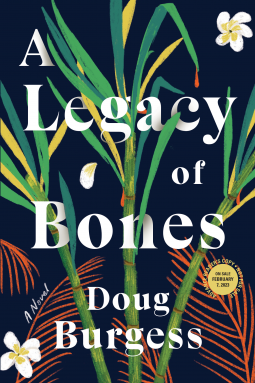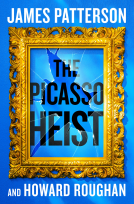
A Legacy of Bones
by Doug Burgess
This title was previously available on NetGalley and is now archived.
Send NetGalley books directly to your Kindle or Kindle app
1
To read on a Kindle or Kindle app, please add kindle@netgalley.com as an approved email address to receive files in your Amazon account. Click here for step-by-step instructions.
2
Also find your Kindle email address within your Amazon account, and enter it here.
Pub Date Feb 07 2023 | Archive Date Feb 14 2023
SOURCEBOOKS Landmark | Sourcebooks Landmark
Description
Some legacies are best abandoned...
A well-placed stick of TNT ignites a full-blown investigation in A Legacy of Bones, a provocative murder mystery exploring the racial and cultural divide on a remote Hawaiian island between landed elite and villagers.
On Kaumaha Island (est 1850), the statue of Amyas Lathrop conceals a terrible secret—a legacy of massacres and madness that infects the island itself. Some will go to any lengths to keep it hidden, others to set it free. But which of them would kill?
Cultural expert Winnie Te Papa, our very own Ms. Marple, will sift through the pieces to track a ruthless murderer through a tangled maze of family alliances, greedy developers, scholars, protestors, and gangsters.
Told in dual timeline, Doug Burgess’s intricate puzzle box mystery traces the consequences of an island’s frenetic beginnings as they snowball through generations. Fans of HBO’s White Lotus will be intrigued by the ever hotly debated questions: what happens next and who get to decide?
Available Editions
| EDITION | Paperback |
| ISBN | 9781728259116 |
| PRICE | $16.99 (USD) |
| PAGES | 288 |
Average rating from 33 members
Featured Reviews
This is a fantastic murder mystery and a spooky ghost tale with important cultural links!
I’ve heard of the Menehune before, but this was my first introduction to the Legend of the Night Marchers.
Author Doug Burgess explores the racial and cultural divide in Hawaii through the issues between the villagers on fictitious Misery Island and the haole elite, the Lathrop family. The villagers consisted of the natives, as well as the Japanese/Filipino immigrants, all of who were plantation workers, and the Lathrops who were the white plantation owners. Readers don’t get too far into the conflict before noticing some parallels in recent Hawaiian history concerning the sugarcane operations. The heart of the issue for both is the land-ownership divide. Burgess points us towards the Māhele and the toppling of the Hawaiian monarchy. He does it in such a way that readers can’t help but see parallels in similar situations on their own turf. If you didn’t know beforehand, you’ll come away with a better understanding of why the idea of owning the āina was such a difficult concept to grasp and also come away with a deeper appreciation for the Hawaiians and their attitude towards their land.
Some of the characters will remind you of Agatha Christie's novels. Mr. Po reminded me of the eccentric Hercule Poirot and Winnie Te Papa reminded me of Miss Marple. Regardless, the well-rounded characters are authentic and engaging. I enjoyed the references to the ‘walkers’ who patrol the Waipi’o Valley at night! The plot is well-paced with a great balance of intrigue and suspense and is obviously penned by an author who loves history.
This book would lend itself well to book clubs as it reminds us of the importance of building worker struggles across ethnic, racial and national divides while maintaining the true flavour of the islands.
This is a ‘meaty’ book and one read-through won’t do it justice! I’m packing it in my suitcase for our Hawaiian vacation next week.
I was gifted this copy by Sourcebooks Landmark and NetGalley and was under no obligation to provide a review.
 kATHLEEN G, Reviewer
kATHLEEN G, Reviewer
A dual time line mystery set on the scenic Hawaiian island of Kaumaha. The Lathrops, who owned most of the land and treated the local population so horribly throughout history, have sold to a developer - except for a statue. And then one of the family is killed. Winnie Te Papa investigates and takes the reader through years of intertwining relationships, myth, and legend as well as abuse of the land and people. It's a lot for a novel that's got a Miss Marple style heroine but there are some gems in here and I learned a bit. Thanks to the publisher for the arc. A good read.
Do you love Miss Marple? Have you ever envisioned her as a Hawaiian woman solving an ancient murder mystery that involves human sacrifice and haunted islands? Look no further, this is the book for you!!
Winnie Te Papa is invited to the small island of Kaumaha as part of a committee to discuss and decide on the matter of its sale to a local hotel mogul. Everything goes smoothly and the decisions are made in seemingly record time, but of course something goes horribly awry in the night. Mrs. Te Papa awakens to find a member of the Lathrop family dead, and a controversial historical site blown to bits. But who did it? She intends to find out, and she'll have to sift through quite a tangled web of family feuds, vengeful spirits, mobsters, blackmail, and secrets to do so.
I really enjoyed this one! The setting is a fictitious small island off the coast of Big Island, settled by a Massachusetts missionary and his family in the 1850s. There is still contention between that family and the Hawaiian natives that live on the island, and this is really the premise for the whole book. I didn't foresee the Lathrop family secret (yikes!), and there were several other little twists and turns throughout the story that were very satisfying.
Overall, this was a really fun little mystery with great characters and a unique setting. It's a very fast paced read, and the last scene (truthfully the whole concept of "the other side of the leaf") will stay with me for a long time to come. Loved it!
Thank you to Doug Burgess, Sourcebooks Landmark, and NetGalley for the opportunity to read and review this ARC!
 Doreen S, Media/Journalist
Doreen S, Media/Journalist
I can’t believe this effortlessly classic murder mystery isn’t part of a series, and sincerely hope it soon will be!
Winnie Te Papa is cultural director for the Office of Hawaiian Affairs, but is well known throughout the islands for her wisdom and, more importantly, kindness. Though she’s getting on in years, his mind is a steel trap, so it isn’t a surprise when she’s asked to sit on an arbitration panel regarding the controversial sale of the privately-owned Kaumaha Island. David Tanaka, the president and CEO of the company looking to develop Kaumaha into a resort, has personally invited her to help settle the dispute.
Ordinarily, Mrs Te Papa has little time for corporations wanting her as a figurehead, but her assistant Marybeth points out that the issue has all the elements she usually enjoys getting involved in. Kaumaha Island has sacred ruins, predatory developer interest and a squabble between the native and <i>haole</i> inhabitants. Mrs Te Papa has to concede the point, so the intrepid duo journey out to the remote locale to see what’s what.
The situation at Kaumaha, as Mrs Te Papa and Marybeth soon discover, is more complicated than either had anticipated. The island was considered cursed by locals and avoided altogether until a Baptist missionary, Amyas Lathrop, brought his flock of native converts to build a settlement there in the 1800s. His descendents still live in a large house on the hill, as does a hardy village of his congregation’s, whose interests are represented by Lani Kapiaho, granddaughter of the Lathrop’s matriarch, Eleanor. Given the dispute between the Lathrops and the villagers regarding the sale of the island, an arbitration panel has been called in, consisting of Mrs Te Papa, anthropologist Robert Ackerman and Judge Rosalind Chan. This formidable trio quickly manages to sort things out to the best of their legal, cultural and historical knowledge, but a murder soon mars the proceedings.
When someone is arrested for the death, Mrs Te Papa senses that something isn’t right, and is moved to interfere. But the more she investigates, the more she worries that the truth will prove damaging to someone whose reputation she wishes to protect. She confers with an old mentor:
QUOTE
[“]But what if the truth hurts her memory even more?”
Duke nodded. “She deserves that truth, whatever it might be. You are not her judge. Nor do you judge those who harmed her. When you uncover an ancient site, do you shrink from interpreting its meaning even if it seems barbaric to us now? Of course not. What use would a scholar be who made up stories about the past just because they sounded pretty? You are simply the vessel. You uncover the truth and let others judge as they will.”
END QUOTE
Girded with this advice, Mrs Te Papa throws herself into uncovering the secrets of Kaumaha Island, as well as the secrets of those present at the fateful arbitration, in hopes of bringing a murderer to justice. While certain of her suspects fit the expected stereotypes, others prove entirely more complex than expected. Take, for example, the property developer who originally invited Mrs Te Papa to participate. Instead of using the strong arm tactics too often defaulted to by those of his ilk, he pushed for arbitration, specifically requesting Mrs Te Papa because of her impact on him when he was graduating high school:
QUOTE
[“]I was valedictorian that year. You gave me an award and told me how proud you were of me. I’d never heard those words before. And that’s why I whispered up at you, ‘Does diversity mean other things besides skin? Like who we love?’ And you leaned down–I was a lot shorter then–and said, ‘Yes, little ‘anela, diversity means you may love whomever you want, and tolerance means everyone will accept that love.’ I never forgot it. So when I needed advice on whether I was being a true Hawaiian, you were the first person I thought of.”
END QUOTE
Mrs Te Papa must work her way through a tangle of secrets from the past and present as she tries to solve both the modern murder mystery and an alarming new conundrum with very old roots. With her keen eye and indefatigable commitment to justice – as well as her strong connection to the lore and beliefs of Hawaii – she makes for one of the most impressive and interesting sleuths I’ve had the pleasure of recently encountering.
But A Legacy Of Bones doesn’t just stand on the charm of a single character. It’s a very solidly constructed novel that is reminiscent of the best classic mysteries, a la Agatha Christie or Dorothy Sayers, and is chock-full of Easter Eggs alluding to its predecessors. Perhaps it was this classic construction that had me marveling at how this book is not already part of a series, so easily does it slip into the established canon. With assured and lived-in prose, this novel is a delight for anyone who enjoys a mystery that refuses to trade on the expected, while also showcasing the vibrancy of life in modern Hawaii.
This book blends Hawaiian historical fiction and a murder mystery seamlessly. I really enjoyed learning more about the Hawaiian culture while trying to guess who the murderer is. This book has dual timelines, multiple POVs, and some great twists.
Thank you @bookmarked and @netgalley for allowing me to read this book ahead of publication in exchange for my honest review.
Readers who liked this book also liked:
We Are Bookish
General Fiction (Adult), Romance, Women's Fiction
Jenny O'Brien
General Fiction (Adult), Historical Fiction, Women's Fiction


















